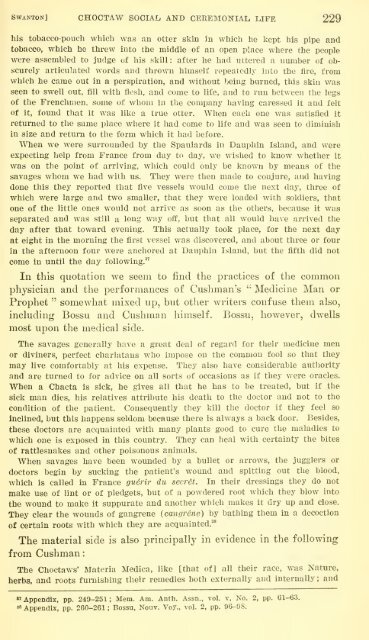siOBX; - Smithsonian Institution
siOBX; - Smithsonian Institution
siOBX; - Smithsonian Institution
You also want an ePaper? Increase the reach of your titles
YUMPU automatically turns print PDFs into web optimized ePapers that Google loves.
SwANTON] CHOCTAW SOCIAL, AND CEREMONIAL LIFE 229<br />
his tobacco-pouch which was an otter skin in which he kept his pipe and<br />
tobacco, which he threw into the middle of an open place where the people<br />
were assembled to judge of his skill: after he had uttered a number of obscurely<br />
articulated words and thrown himself repeatedly into the fire, from<br />
which he came out in a perspiration, and without being burned, this skin was<br />
seen to swell out, fill with flesh, and come to life, and to run between the legs<br />
of the Frenchmen, some of whom in the company having caressed it and felt<br />
of it, found that it was like a true otter. When each one was satisfied it<br />
returned to the same place where it had come to life and was seen to diminish<br />
in size and return to the form which it had before.<br />
When we were surrounded by the Spaniards in Dauphin Island, and were<br />
expecting help from France from day to day, we wished to know whether it<br />
was on the point of arriving, which could only be known by means of the<br />
savages whom we had with us. They were then made to conjure, and having<br />
done this they reported that five vessels would come the next day, three of<br />
which were large and two smaller, that they were loaded with soldiers, that<br />
one of the little ones would not arrive as soon as the others, because it was<br />
separated and was still a long way off, but that all would have arrived the<br />
day after that toward evening. This actually took place, for the next day<br />
at eight in the morning the first vessel was discovered, and about three or four<br />
in the afternoon four were anchored at Dauphin Island, but the fifth did not<br />
come in until the day following."<br />
In this quotation we seem to find the practices of the common<br />
physician and the performances of Cushman's " Medicine Man or<br />
Prophet " somewhat mixed up, but other writers confuse them also,<br />
including Bossu and Cushman himself. Bossu, however, dwells<br />
most upon the medical side.<br />
The savages generally have a great deal of regard for their medicine men<br />
or diviners, perfect charlatans who impose on the common fool so that they<br />
may live comfortably at his expense. They also have considerable authority<br />
and are turned to for advice on all sorts of occasions as if they were oracles.<br />
When a Chacta is sick, he gives all that he has to be treated, but if the<br />
sick man dies, his relatives attribute his death to the doctor and not to the<br />
condition of the patient. Consequently they kill the doctor if they feel so<br />
inclined, but this happens seldom because there is always a back door. Besides,<br />
these doctors are acquainted with many plants good to cure the maladies to<br />
which one is exposed in this country. They can heal with certainty the bites<br />
of rattlesnakes and other poisonous animals.<br />
When savages have been wounded by a bullet or arrows, the jugglers or<br />
doctors begin by sucking the patient's wound and spitting out the blood,<br />
which is called in France gu6rtr du secret. In their dressings they do not<br />
make use of lint or of pledgets, but of a powdered root which they blow into<br />
the wound to make it suppurate and another which makes it dry up and close.<br />
They clear the wounds of gangrene (cangrene) by bathing them in a decoction<br />
of certain roots with which they are acquainted.^<br />
The material side is also principally in evidence in the following<br />
from Cushman<br />
The Choctaws' Materia Medica, like [that of] all their race, was Nature,<br />
and<br />
herbs, and roots furnishing their remedies both externally and internally ;<br />
*^ Appendix, pp. 249-251; Mem. Am. Anth. Assn., vol. v. No. 2, pp. 61-63.<br />
»» Appendix, pp. 260-261 ; Bossu, Nouv. Voy., vol. 2, pp. 96-98.

















